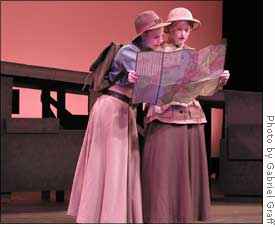| << Front page | Arts | April 23, 2004 |
On the Verge opens with mixed reviews
Production gives superficial life to superficial work
 |
||
| Voyage of discovery: On the Verge asks audience to journey through time with its two leading ladies. | ||
It is not often that the set, lighting and sound of a show manage to outshine the production itself. However, in the Oberlin theater department’s production of On the Verge, or The Geography of Yearning, that was exactly the case. The department is extremely fortunate to have scenic designer Damen Mroczek and light/sound designer Jen Groseth involved in their production of On the Verge. Physically dynamic — a multilevel set comprised of platforms, ladders and ramps, but simultaneously neutral, with the entirety of the set painted gray — Mroczek’s set suited the needs of this production superbly. The ambiguity of the set allowed for Groseth’s lighting to transform the stage from jungle to arctic to an Esso station in 1955.
Also notable is Groseth’s sound design. Sometimes generic but always appropriate, sound effectively assists in transforming the stage. When technical aspects of theater are often overlooked both by an audience and in reviews, it is a joy to commend two “techies” on a job exceedingly well done. If the rest of the production could have attained this level of quality, this production would be worthy of strong recommendation. This is not the case.
Gertrude Stein wrote, “Anecdotes are not literature.” It appears that Eric Overmeyer, author of On the Verge, or The Geography of Yearning, disagrees. He has delivered to us a collection of lists, of anecdotes and topical references. He has built three or four simple mechanisms for delivering the substance of the play and uses them with a sense of abandon and without a sense of integrity. He has brought to life three paper-thin women and asks us to discover what they are supposed to discover and to feel the excitement that they (nearly incessantly) feel. Director Chris Flaharty, in his program notes, requests that the audience “embrace” this show. Unfortunately, to embrace this show and this production is like embracing a dramatic Lewis and Clark expedition without the metaphorical Sacagawea: a journey that is without direction that ends with no discernible discovery.
The action of the play revolves around three female explorers: Mary, a realist with a penchant for the seedy side of anthropology played by senior Mary Ross, Fanny, a cynical columnist with a sharp tongue played by junior Jessica Bedwinek, and Alexandra, a self-fancied lyricist played by junior Whitney Laucks. They begin a new journey on a beach in 1888 but are somehow gradually transported back through time to 1955. During the journey, the three women talk of past explorations “osmosing” facts about the future. Certain instances during their journey are enjoyable, such as Alexandra’s vision of Red China, but the whole of the dialogue is laborious and facile. Ross came closest to a complete character, but hers is the least interesting of the three. Bedwinek was able to snap out her Wildean witticisms, such as they may be, with the proper balance of venom and saccharine, but, because she was so adept at playing this aspect, the rest of her character was watery. Laukas was burdened with a character that is the vehicle for most of Overmeyer’s joke meatballs, but she allowed the character to be just that. While she played the jokes to the fullest extent, markedly when she discovers surfing, this is not the stuff of character.
Because the three actors share the same vocal tone and must rely on a Swiss cheese script, each character is separated only by the most surface collection of idiosyncrasies. In the play, Mary informs Fanny that, “tone of voice is everything.” Though the line was in the production, the three actors failed to take this advice.
While the three leads were mediocre, the entirety of the acting was not as such. In the words of Denise Williams, “Let’s hear it for the boys.” Seniors Andy Campbell and Bacilio Mendez II were sublime in their performances of multiple characters. Though they were not deep characters, Campbell’s Alphonse, a French-German cannibal, and Gus, a teenage gas station attendant, displayed an admirable range of acting ability. Mendez exhibited the same talent, playing roles as diverse as a lounge singer, a fortune telling automaton and a yeti. His crooning Nicky Paradise was particularly good as Mendez was the embodiment of the 50’s swaggering songster.
The only drawback was that Mendez was forced to lip synch to standards like “The Way You Look Tonight.” Though it is doubtful that Mendez’s voice is comparable to that of Ol’ Blue Eyes, live singing would be favorable when compared to recordings of recognizable singers. (Also regrettable was the choice of Big Bad Voodoo Daddy, a conspicuous group from the neo-swing movement of the late 90s, as background for Nicky’s entrance.)
Why this play? I cannot tell. Ross, Bedwinek and Laucks were stifled by weakly-written characters. Mendez and Campbell benefited from multiple roles that allowed for a showcase of their ability. The tech was magnificent but that skill could have been devoted to another production.
In short, this is a production worth seeing, but do not go expecting to see a well-accomplished play or consistent entertainment. Instead, go to watch two graduating seniors’ virtuosity and a rare bit of superlative stagecraft.
About us
Subscriptions
Advertising
|